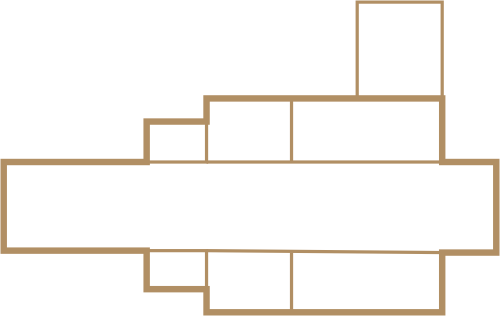For this church:    |
| |||||||||||||||||||||||||||||||||||||||||||||||||||||||||||||||||||||||||||||||||||||||||||||||||||||||||||||||||||||||||||||||||||||||||||||||||||||||||||||||||||||||||||||||||||||||||||||||||||||||||||||||||||||||||||||||||||||||||||||||||||||||||||||||||||||||||||||||
Key to Stained-Glass Windows |
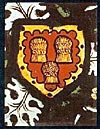 Kempe's mark Kempe's mark |
It is considered most of the stained glass within the chapel was produced, not surprisingly owing to his connections, by Charles Eamer Kempe (1837-1907) a past student of architecture under George Frederick Bodley, the Chapel’s designer. Kempe’s mark can be found on particular windows with Bodley’s on the corresponding side. Kempe had studied previously for the priesthood at Pembroke College at Oxford, however, owing to a speech impediment, he belayed his ambition to become a clergyman, and so decided to beautify churches instead.
Under Bodley he learnt the art of decorating church walls and ceilings, but also made a serious study of mediaeval stained glass at the influential studios of Clayton and Bell, where standards of design and craftsmanship were high. This culminated with him opening in 1866 his own glass studio in London.
The stained glass designers often marked their glass within the design and C E Kempe’s trademark was a golden garb or wheatsheaf taken from his own coat of arms. When Kempe’s nephew, Walter Tower took the company over following his death, the mark was adjusted to include a black tower above the golden garb. Owing to the lack of orders the company closed in 1934.
Chancel
1The East Window
The tracery stonework at the head of this window incorporates the instruments of the Passion, and at the extreme top a crowned Holy Name, Jesus, [in Greek], in a glory.
This window itself gives a view of Kempe’s late Gothic style with English and Flemish elements, executed in white tabernacle work relieved with soft half tones and formulated colour tones of the figures. The cartoon, the full drawing of the window, seeks to demonstrate the works of Christ, according to apostolic tradition, energised by His crucifixion on the Cross, and being nourished by the Body and Blood of Christ in the Eucharist, illuminated by the charitable works and mercy and reassured by the teaching and authority of the Fathers. At the base of the window runs the prayer, Orate pro bono statu Henrici Septimi Ducis Novi Castelli sub Lyme, hujus Ecclesiae Fundatoris, [Pray for the good estate of Henry, Seventh Duke of Newcastle-under-Lyne, founder of this Church].
The centre major light of five, within the stone mullioned window, depicts the Crucifixion, with Adam and Eve below, [copied from part of a 1504 engraving by Albrecht Dürer], standing before the Tree of Knowledge of good and evil in the midst of the Garden of Eden. This is underpinned by a pelican in piety, a symbol of Christ the Redeemer; for as it was reputed to feed its young with its own blood to save them from death, so our saviour shed His blood to save us from death eternal. The legend underneath reads, Jesus Christus Pelicanus Noster.
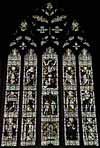 East window East window |
 Detail Detail |
 Adam and Eve Adam and Eve |
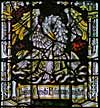 Pelican in Piety Pelican in Piety |
Various saints are arranged in tiers across the window.
The upper tier
This underscores the apostolic origin of the church with:
 |
St Peter |
depicted with keys and a book - Peter was called and trained for the Apostleship and clothed with the primacy of the Apostles, which he exercised in a most unequivocal manner after Christ’s Ascension into Heaven | ||
 |
||||
 |
The Blessed Virgin Mary |
the mother of Jesus Christ, the mother of God. Since the first century, devotion to the Virgin Mary has been a major element of the spiritual life of a vast number of Christians | ||
 |
||||
 |
St John the Divine |
often referred to as John of Patmos, or John the Theologian and the message he received is considered divine Revelation by most Christians. John of Patmos, the author of the Book of Revelation, is traditionally believed to be the same person as both John, the apostle of Jesus and John the Evangelist. Some biblical scholars now contend that these were separate individuals | ||
 |
||||
 |
St Paul |
Paul's influence on Christian thinking arguably has been more significant than that of any other New Testament author | ||
The middle tier
This depicts the following all known for conspicuous works of mercy:
 |
St Joseph of Arimathaea |
depicted with tomb and crown of thorns – Joseph after permission from Pilate took the body of crucified Jesus to place him in a sepulchre [John 19:38] | ||
 |
||||
 |
St Hugh of Lincoln |
noted with a swan and a model of Lincoln Cathedral - As a bishop he was exemplary, constantly in residence or travelling within his diocese, generous with his unbounded charity to the poor and it was long remembered how he used to tend with his own hands people afflicted with leprosy then so common in England, scrupulous in the ecclesiastical appointments he made. Hugh's primary emblem is a white swan in reference to the story of the swan of Stowe which had a deep and lasting friendship for Hugh, even guarding him while he slept. The swan would follow him about constantly, and was his constant companion whilst he was at Lincoln. He is the patron saint of sick children, sick people, and swans | ||
 |
||||
 |
St Mary Magdalene |
seen with a box of ointment - Mary Magdalene or Mary of Magdala is described, both in the canonical New Testament and in the Apocrypha, as one of the most important women in the movement of Jesus. Mary was one of many women who followed Jesus to the very end, having accompanied Him and the twelve apostles during their travels and, according to all four Gospels in the Christian New Testament, Jesus had chosen Mary to be the first witness of His resurrection from the dead | ||
 |
||||
 |
St Christopher |
seen carrying a budding staff and the Christ-child - There is almost nothing historical known about the life, or his death. However, there are several legends about him including one attributed to him in the 13th century by Archbishop Jacobus de Voragine in which it advises - Christopher was about to cross a river when a child asked to be carried across. When he put the child on his shoulders he found the child was unbelievably heavy. The child is later revealed to be Jesus Christ carrying the weight of the whole world. This is why Christopher became the patron Saint of Travellers holding patronage of things related to travel and travellers and is invoked against storms, plagues, lightning, bookbinders, epilepsy, toothache, etc. | ||
The bottom tier
The bottom tier of panels includes carvings of those who represent the teaching authority and tradition of the Church, through the four Doctors of the Western Church as noted below. It will be realised they are almost identical to the statues in the choir stalls save that St Augustine carries a burning heart instead of a transfixed one, St Jerome is accompanied by a lion, and St Ambrose carries a scourge, not as an element of the Passion but signifying his work in the expulsion of the Arian sect from Italy and the subsequent penance he inflicted on the Emperor Theodosius I:
 |
St Augustine of Hippo |
can be seen wearing a chasuble – is also known as St Augustine or St Austin, was a Berber philosopher and theologian. In the Catholic Church and the Anglican Communion, he is a saint and pre-eminent Doctor of the Church, and the patron of the Augustinian religious order. Many Protestants, especially Calvinists, consider him to be one of the theological fathers of reformation teaching on salvation and divine grace. St Augustine of Hippo is the patron of brewers because of his conversion from a former life of loose living, which included parties, entertainment, and worldly ambitions | ||
 |
||||
 |
St Gregory |
although the first monk to become Pope, he took to monasticism initially as it was established by St Benedict. Whilst he was a trained Roman lawyer and administrator, a monk, missionary and preacher, he was above all known as a physician of souls, a leader of men, and the real father of medieval papacy. St Gregory is also well-known for his writings, which were more prolific than those of any of his predecessors as Pope and for this reason English translations of Orthodox texts will sometimes list him as ‘Gregory Dialogus’. He is the patron saint of musicians, singers, students, and teachers | ||
 |
||||
 |
St Jerome |
is noted wearing a cope - known for his studies, translation and revision of the Old Testament according to the Hebrew but his extensive writings may be summed up under the headings of the Bible, theological controversies, historical and other translation work. He also undertook a revision of the Latin Bible, to be based on the Greek Testament, and much of the controversial interpretation contributed to the Vulgate Bible. He is recognized in the Roman Church as the patron saint of translators, librarians and encyclopaedists | ||
 |
||||
 |
St Ambrose |
also wearing a cope - was traditionally credited with composing the hymn, Te Deum, which he is said to have composed when he baptised St Augustine, his celebrated convert. As one of the most illustrious Fathers and Doctors of the Roman Church he was chosen with others to uphold the venerable Chair of the Prince of Apostles in the tribune of St Peter’s at Rome. | ||
The Lady Chapel
2,3,4The Lady Chapel has three stained glass windows all provided as a wedding gift when, in February 1889, the Duke of Newcastle married Miss Kathleen Florence May Candy, who was from an Irish sporting family, the Westernras. Whilst the windows were prepared by Kempe they were partially funded by the tenants from the Duke’s estate. The symbolic representation within the glass is of the Annunciation, The Adoration of the Shepherds, and the Adoration of the Magi.
 Window 2 Window 2 |
 Window 3 Window 3 |
 Window 4 Window 4 |
South Transept
5 Decorated Gothic window, above the South door, produced by Kempe, represents the nine orders of angels, skilfully arranged in tiers.
 |
 Upper tier Upper tier |
 Second tier Second tier |
 Bottom tier Bottom tier |
The upper tier includes:
 |
Cherubim |
with six wings and bearing a censer | ||
 |
||||
 |
Thrones |
clothed in royal robes and carrying a small throne | ||
 |
||||
 |
Seraphim |
again with six wings but bearing a scroll with the words, Sanctus, Sanctus, Sanctus. | ||
It is considered the names Cherubim and Seraphim are, when considering the cartoon, incorrectly placed and should be interchanged.
The second tier incorporates:
 |
Dominions |
again in royal robes but carrying a sceptre and sword | ||
 |
||||
 |
Powers |
armour clad, with a mace and the head of Satan below | ||
 |
||||
 |
Virtues |
again armoured, but with a censer and battleaxe | ||
The bottom tier embraces the last of the nine:
 |
Archangels |
partly armed, but wearing a tunic, a belt with bells, a cope and bearing a sword and trumpet | ||
 |
||||
 |
Principalities |
again armour clad, but with a lily on the right hand and a lance in the left | ||
 |
||||
 |
Angels |
clothed in a deacon’s vestments and carrying a sceptre | ||
Nave
 |
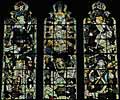 Detail of the Detail of the west window |
The West Window, above the doorway, incorporates in grisaille work, one of Kempe’s favourite subjects, the vine. The detail indicates the dynastic decent of Christ from Jesse, the father of David, through the principal kings of Judah who are seated on the branches of the vine. In the lower reaches of the window Jesse is shown asleep and from his body springs the stem of this vine upon which is etched Jesse Virgo floruit [the rod of Jesse hath blossomed], [Isaiah 11:1] As with many iconic stories, it is very often what is not said which may be poignant to the reasoning for the feature to be incorporated here at Clumber. Viz., root of Jesse, which shall stand for an ensign of the people; to it shall the Gentiles seek: and his rest shall be glorious. [KJV Isaiah 11:10]. Consider the young age and infirmity of the Duke.
The centre light clearly indicates David, son of Jesse, with harp and Psalter, and the inscription, Ipse invocabit me Pater meus es Tu, [He shall cry unto me, ‘Thou art my Father’]. Solomon is adjacent with the Book of Wisdom.
The northern light represents:
 |
Rehoboam |
a king of Judah 931-913 B.C., and son of Solomon, [1Kings14:21-31 & 2Chron10-12] | ||
 |
||||
 |
Asa |
seen holding a fortress - king of Judah 911-870 B.C. [1Kings15:9-24 & 2Chron14-16] | ||
 |
||||
 |
Abijah |
Solomon’s grandson, a king of Judah 931-911 B.C. [1Kings15:1-8], 913-911 B.C. [2Chron13] | ||
 |
||||
 |
Jehoram |
depicted with a sword – king of Judah 853-841 B.C. [2Kings8:16-24 & 2Chron21]. Son of a good father and grandfather, he was ruined by his marriage to a wicked woman, Athaliah, a daughter of the infamous Jezebel | ||
The southern light represents:
 |
Ahaz |
a king of Judah 735-716 B.C. [2Kings16 & 2Chron28] | ||
 |
||||
 |
Hezekiah |
seen holding the ‘Dial of Ahaz,’ the sign of the miraculous recovery from sickness - a king of Judah 716-687 B.C. [2Kings18-20 & 2Chron29-32]. When Sennacherib again invaded Judah in 701 B.C. he failed in his attempts from siege to attack against Jerusalem as Hezekiah had strengthened the wall, built the water tunnel some 1750 ft long, and made great military preparations. Then followed the great deliverance by the Angel of the Lord [2Kings19:35]. This victory brought Hezekiah great prestige and power | ||
 |
||||
 |
Uzziah |
with a sword – a king of Judah 792-740 B.C. part of which may have been as co-regent with his father, Amaziah [2Kings15:1-7 & 2Chron26] | ||
 |
||||
 |
Jehoshaphat |
a king of Judah 872-848 B.C. [1Kings22:41-50 & 2Chron17-20] | ||
The top centre light represents:
 |
the crown and glory of the above mentioned line of kings, the infant Saviour in His Mothers arm’s. |
Vestry
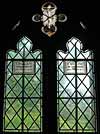 |
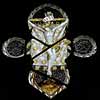 Detail Detail |
The Vestry has a stained glass window by Comper (not normally seen by the public). It consists of a quatrefoil with a cartoon of Christ on the Cross with the inscription 'INRI' [Jesus Nazarenus Rex Judaeorum, Jesus of Nazareth, King of the Jews] and a banner behind in brown, yellow and clear colours. There are two other separate panels beneath with the inscription 'V Adoramus te xte et benedicimus, alleluia H quia p croc tua irdimish mundu alleluia'.
North Transept and Clerestory
The Clerestory & North Transept Windows incorporate some stained glass in the tracery. These show sacred emblems and the crests, supporters, and some quartering’s related to the founder.
Other Windows
There are many other windows in the chapel of clear glass, mainly diamond quarries.



